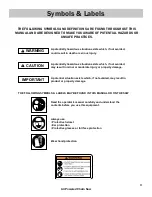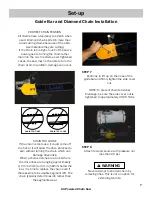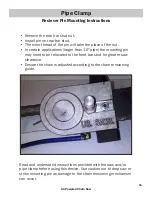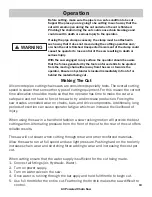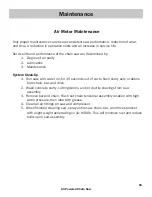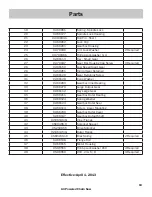
4
Safety
© 2011 ICS, Blount Inc.
F/N 70944 May 2011
TITLE
633GC / 633F4 OPERATOR’S MANUAL
4
SYMBOLS & LABELS
THE FOLLOWING SYMBOLS & DEFINITIONS ARE FOUND THROUGHOUT THIS MANUAL AND
ARE DESIGNED TO MAKE YOU AWARE OF POTENTIAL HAZARDS OR UNSAFE PRACTICES.
A potentially hazardous situation exists which, if not avoided,
could result in death or serious injury.
A potentially hazardous situation exists which, if not avoided,
may result in minor or moderate injury or property damage.
A potential situation exists which, if not avoided, may result in
product or property damage.
THE FOLLOWING SYMBOLS & LABELS MAY BE FOUND IN THIS MANUAL OR ON THE SAW
Read the operator’s manual carefully and understand the
contents before you use this equipment.
Always use:
• Protective helmet
• Ear protection
• Protective glasses or full face protection
Wear hand protection
IMPORTANT
WARNING
CAUTION
Chain breakage can result in high-speed ejection of parts, which can result in death or
serious personal injury to operators or bystanders. The items listed below are critical to
minimizing the risk of chain breakage and injury.
• DO NOT operate a diamond chain saw with damaged, modified, broken, or missing side
cover, bottom guard flap. The side cover, bottom guard, and guard flap provide protection
against contact with moving parts, ejected debris, broken chain, thrown water and
concrete slurry.
• DO NOT operate a saw with loose, missing, damaged, or improperly repaired parts.
• DO NOT install or run the chain backwards. The bumper must lead the segment into the
cut. (Applies to concrete chains only.)
This symbol applies to all information listed on this page
F/N 70944 May 2011
© 2011 ICS, Blount Inc.
TITLE
633GC / 633F4 OPERATOR’S MANUAL
5
SAFETY
WARNING
THE FOLLOWING SYMBOL APPLIES TO ALL THE ITEMS LISTED ON THIS PAGE
A potentially hazardous situation exists which, if not avoided,
could result in death or serious injury.
Chain breakage can result in high-speed ejection of parts, which can result in death or
serious personal injury to operators or bystanders. The items listed below are critical to
minimizing the risk of chain breakage and injury.
• DO NOT operate a diamond chainsaw with a damaged, modified, broken, or missing side
cover, bottom guard, or guard flap. The side cover, bottom guard, and guard flap provides
protection against contact with moving parts, ejected debris, broken diamond chain,
thrown water and concrete slurry.
• DO NOT operate a saw with loose, missing, damaged or improperly repaired parts.
• DO NOT install or run the chain backwards. The bumper must lead the segment into
the cut.
• DO NOT insert a diamond chainsaw into a slot narrower than the chain segments. Rapid
pushback might occur. Reference: Most diamond segments are .225 inches (5.72 mm)
wide.
• DO NOT use damaged, modified or improperly repaired chain.
• DO NOT run a diamond chainsaw upside-down. Concrete debris can fly back into the
operator’s face.
• NEVER cut ductile iron pipe with the saw (except when using PowerGrit
TM
Cutting
System). Segment loss or diamond chain breakage may occur.
• See page 16 for information about cutting ductile iron pipe with PowerGrit
TM
.
• DO NOT insert a diamond chain saw into a slot narrower than the chain segments. Rapid
push back might occur. Reference: Most diamond segments are .225 inches (5.72 mm)
wide.
• DO NOT use damaged, modified or improperly repaired chain.
• DO NOT run a diamond chain saw upside-down. Concrete debris can fly back into the
operator’s face.
• DO NOT cut ductile iron pipe with concrete chain. Segment loss or diamond chain
breakage may occur.
• DO NOT cut concrete with ductile iron chain. Segment loss or diamond chain breakage
may occur.
Air Powered Chain Saw



